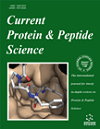- Home
- A-Z Publications
- Current Protein and Peptide Science
- Previous Issues
- Volume 17, Issue 6, 2016
Current Protein and Peptide Science - Volume 17, Issue 6, 2016
Volume 17, Issue 6, 2016
-
-
Towards the Molecular Imaging of Prostate Cancer Biomarkers Using Protein-based MRI Contrast Agents
More LessAuthors: Fan Pu, Shenghui Xue, Jingjuan Qiao, Anvi Patel and Jenny J. YangProstate cancer is the most common cancer for man with a high mortality rate due to a lack of non-invasive accurate and sensitive molecular diagnostic methods. The molecular imaging of cancer biomarkers using MRI with its spatial and temporal resolution, however, is largely limited by the lack of contrast agents with high sensitivity, targeting specificity and deep tumor penetration. In this review, we will first overview th Read More
-
-
-
Identification of Disease States and Response to Therapy in Humans by Utilizing the Biomarker EGFR for Targeted Molecular Imaging
More LessAuthors: Xilin Sun, Shaowei Li and Baozhong ShenThe epidermal growth factor receptor (EGFR) plays important roles in cell proliferation, suppression of apoptosis, increased motility, and recruitment of neovasculature. Overexpressed or mutated EGFR has been an important biomarker for cancer diagnosis and molecular target for many anticancer drugs because it frequently occurs in many common human cancers. Localizing and estimating the expression of EGFR Read More
-
-
-
Small Peptide and Protein-based Molecular Probes for Imaging Neurologi-cal Diseases
More LessAuthors: Gianina Teribele Venturin and Zhen ChengNeurologic disorders are prevalent diseases in the population and represent a major cause of death and disability. Despite the advances made during recent decades, the early diagnosis of these diseases remains a challenge. Determining the pathophysiology of such disorders is also challenging and is a requirement for the development of new drugs and treatments. Molecular neuroimaging studies can help fill these Read More
-
-
-
The Nuclear Molecular Imaging of Protein Brain Receptors in Chronic Pain
More LessAuthors: Chen Su, Rong Hu, Yonghong Gu, Rui Han, Xuebin Yan, Qin Liao and Dong HuangChronic pain is thought to be a brain disease, but the mechanisms are not well-known. In recent years, brain imaging has become an indispensable tool for pain research. For example, nuclear molecular imaging is a safe and noninvasive technology that allows researchers to probe potential brain regions of interest with suitable biomarkers. These studies help us to understand the central mechanisms of chronic pain states in Read More
-
-
-
Integrin (αvβ3) Targeted RGD Peptide Based Probe for Cancer Optical Imaging
More LessAuthors: Zhiguo Liu, Lun Yu, Xiaobo Wang, Xintong Zhang, Meihui Liu and Wenbin ZengIntegrins have an important impact on the regulation of normal and tumor cell migration and survival, especially the integrin αvβ3 and its role in angiogenesis and tumor metastasis. Owing to the role of integrins, non-invasive imaging of αvβ3 expression in diseased tissue will be of great benefit in directing adjuvant therapy for cancer patients. To this end, RGD peptide based probes for optical imaging have emerged as a r Read More
-
-
-
PEGylated Peptide-Based Imaging Agents for Targeted Molecular Imag-ing
More LessAuthors: Huizi Wu and Jiaguo HuangMolecular imaging is able to directly visualize targets and characterize cellular pathways with a high signal/background ratio, which requires a sufficient amount of agents to uptake and accumulate in the imaging area. The design and development of peptide based agents for imaging and diagnosis as a hot and promising research topic that is booming in the field of molecular imaging. To date, selected peptides have been i Read More
-
-
-
Hydroxyproline: A Potential Biochemical Marker and Its Role in the Pathogenesis of Different Diseases
More LessHydroxyproline is a non-essential amino acid found in collagen and few other extracellular animal proteins. It’s two isomeric forms trans-4-hydroxy-L-proline and trans-3-hydroxy-L-proline play a crucial role in collagen synthesis and thermodynamic stability of the triple-helical conformation of collagen and associated tissues. Various abnormalities in hydroxyproline metabolism have been shown to play key roles in the pathophy Read More
-
-
-
The Coronin Family and Human Disease
More LessAuthors: Xiaolong Liu, Yunzhen Gao, Xiao Lin, Lin Li, Xiao Han and Jingfeng LiuThe Coronin family is one of the WD-repeat domain containing families that are diverse in both of their structures and functions. The first coronin was identified in the cytoskeleton composition of Dictyostelium discoideum, which was discovered to regulate the actin functions. So far, 723 coronins have been identified throughout the eukaryotic kingdom by bioinformatics analysis in 358 species. In mammals, 7 coronins hav Read More
-
-
-
Disorder in Milk Proteins: α-Lactalbumin. Part B. A Multifunctional Whey Protein Acting as an Oligomeric Molten Globular “Oil Container” in the Anti-Tumorigenic Drugs, Liprotides
More LessThis is a second part of the three-part article from a series of reviews on the abundance and roles of intrinsic disorder in milk proteins. We continue to describe α-lactalbumin, a small globular Ca2+-binding protein, which besides being one of the two components of lactose synthase that catalyzes the final step of the lactose biosynthesis in the lactating mammary gland, possesses a multitude of other functions. In fact, rec Read More
-
Volumes & issues
-
Volume 26 (2025)
-
Volume 25 (2024)
-
Volume 24 (2023)
-
Volume 23 (2022)
-
Volume 22 (2021)
-
Volume 21 (2020)
-
Volume 20 (2019)
-
Volume 19 (2018)
-
Volume 18 (2017)
-
Volume 17 (2016)
-
Volume 16 (2015)
-
Volume 15 (2014)
-
Volume 14 (2013)
-
Volume 13 (2012)
-
Volume 12 (2011)
-
Volume 11 (2010)
-
Volume 10 (2009)
-
Volume 9 (2008)
-
Volume 8 (2007)
-
Volume 7 (2006)
-
Volume 6 (2005)
-
Volume 5 (2004)
-
Volume 4 (2003)
-
Volume 3 (2002)
-
Volume 2 (2001)
-
Volume 1 (2000)
Most Read This Month
Article
content/journals/cpps
Journal
10
5
false
en


